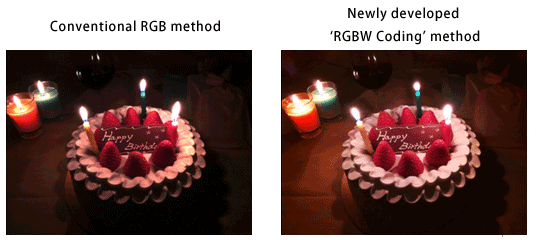Sony’s RGBW coding enhances low-light photographs
Soon to be released smartphone camera sensor shows tremendous promise
Smartphone cameras are notorious for taking bad pictures in low light. This may change soon, though, according to Sony. As per an announcement made by the company this week, its new RGBW coding function is an effective solution to enhancing low-light pictures taken with a smartphone camera.

Sony demonstrates difference in quality of picture between RGB and RGBW coding methods. (Via: sony.net)
The company enhanced its current RGB (red-green-blue) coding function by adding white light detectors to the normal range of RGB pixels. Doing this, researchers discovered, increased the sensor’s light sensitivity, and allowed the camera to provide better-quality shots across a range of lighting scenarios.
Some background
The proliferation of smartphones in the consumer market has resulted in an unforeseen issue for many: the inability to take quality pictures regardless of the ambient light. Generally speaking, this frustration is because smartphone cameras use smaller lenses and image sensors than actual cameras, leading to blurred or dark pictures in low light.
Sure, you could use a flashlight app to leave the camera’s flash on, but that would quickly drain the phone’s battery and possibly wash-out part or all of the picture you’re trying to take. The solution, Sony researchers discovered, was to add a new row of pixels.
What do white pixels do?
White-light-sensing pixels don’t have a color filter covering them; therefore, they can’t distinguish color. This allows them to have a greater sensitivity to light across the entire visible spectrum.
With their addition to the coding function, they’re able to capture greater detail of the shadowy areas of an image that otherwise go undetected by RGB pixels. Specially designed software then combines information gathered by the white pixels with details recorded by the RGB pixels. This increases the dynamic range of the photo, and allows the camera sensor to provide better quality images.
It should be noted that according to Sony, the addition of white pixels isn’t enough to address the problem of image quality. In fact, introducing white-light sensing pixels alone would actually lead to picture degradation. In their announcement, the company claimed that it was the unique combination of their technology and signal processing that led to the camera sensor’s superior sensitivity and higher-quality images.
Will these extra pixels have any effect on the size of the phone?
All of this new technology being added to a small amount of space begs the obvious question: Will this affect the size of the smartphone? As per Sony’s announcement, apparently not. The company states that “. . . while the individual pixels of the newly developed models are extremely minute at 1.12μm, the incorporation of the ‘RBGW Coding’ function has realized a SN ratio (signal-to-noise ratio) equivalent to that of a unit pixel size of 1.4μm under conventional methods, which in turn has enabled the image sensors to achieve a higher resolution at a more compact size.”
Roll out date
For the past few years, manufacturers have focused on megapixels as their selling point for smartphone cameras. Naturally, a smartphone camera with greater versatility has consumers eager to get their hands on one sooner rather than later.
Sony hopes to have samples of the new camera sensor shipped out to manufacturers as early as March, with the goal being to have them on the consumer market either by the end of this year or early 2013. ■
References for this article via:
Advertisement
Learn more about Electronic Products Magazine





